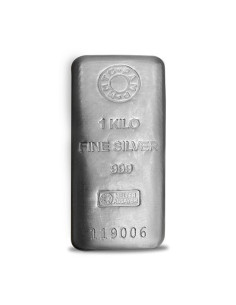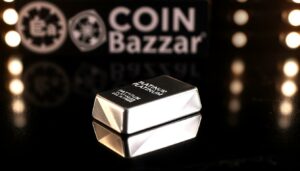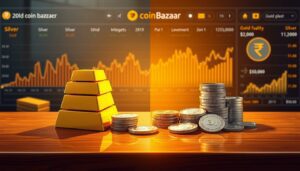Exclusive Deals & Trending Items
In 2025, the appeal of gold is growing due to inflation and global tensions. You face a choice: gold ETFs or physical gold. Each has its own set of pros and cons, which we’ll discuss here.
By April 7, 2025, gold prices had climbed, making it a popular choice for investors. The debate is whether to go for gold ETFs or physical gold. Knowing the differences between gold ETFs and physical gold is essential for a wise decision.
Key Takeaways
- Gold ETFs offer a convenient way to invest in gold without the need for physical storage.
- Physical gold provides a tangible asset that can be held in your hand.
- The advantages of gold ETFs include ease of trading and diversification benefits.
- Physical gold can be used as a hedge against inflation and market volatility.
- Understanding your investment goals is key to choosing between gold ETFs and physical gold.
The Gold Investment Landscape in 2025
In 2025, the gold investment scene is changing a lot. You might have seen gold prices go up a lot. This is because of high inflation and world tensions, with prices rising by about 68% since 2023 started.
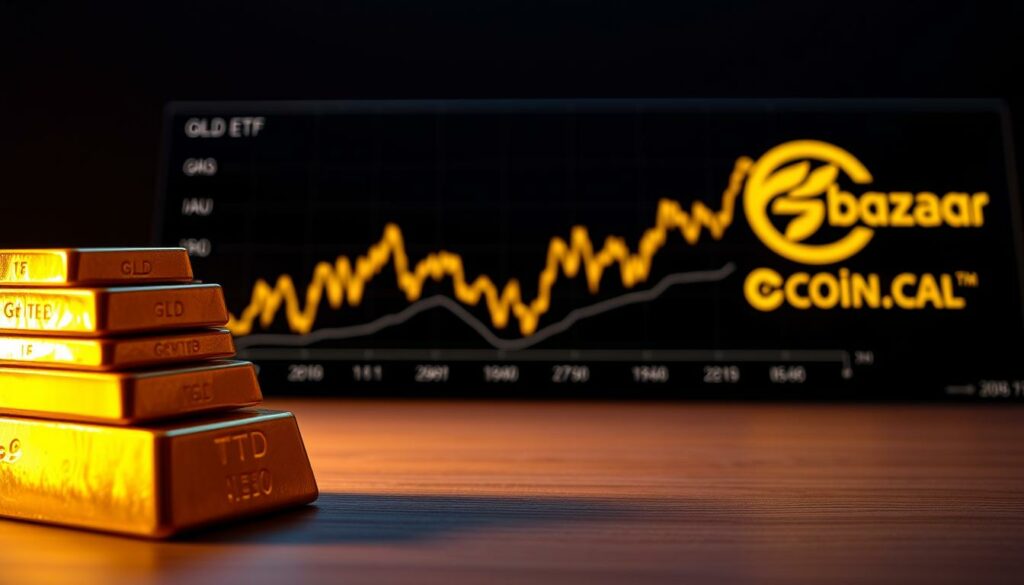

Current Gold Market Trends in India and Globally
The gold market is seeing big changes, both in India and worldwide. In India, gold demand usually goes up during festivals and weddings. But in 2025, people are also investing in gold because of economic worries. Globally, gold ETFs are becoming more popular as people seek safe investments.
Factors Driving Gold Investment Decisions
Many things are making people think about investing in gold. World tensions and economic problems make gold seem like a good choice. Also, digital gold platforms are making it simpler to invest in gold, which is driving more investment choices.
When you think about investing in gold, you have a few options. You can choose gold ETFs or physical gold. Knowing the liquidity of gold ETFs and the tangible nature of physical gold can help you decide better.
Understanding Gold ETFs vs Physical Gold
Ever wondered what makes Gold ETFs different from physical gold? Let’s explore the details.
What Are Gold ETFs?
Gold ETFs are funds traded on exchanges that follow gold’s price. They let you invest in gold without owning it physically. This way, you can enjoy gold’s price changes without the hassle of storing it.
How Gold ETFs Work
Gold ETFs hold gold bullion or gold-related assets. Buying a Gold ETF share means you own a part of the fund’s gold. The value of your shares changes with gold’s price.
Major Gold ETF Providers
Some top Gold ETF providers are:
- SPDR Gold Shares
- iShares Gold Trust
- Gold ETF by HDFC Asset Management
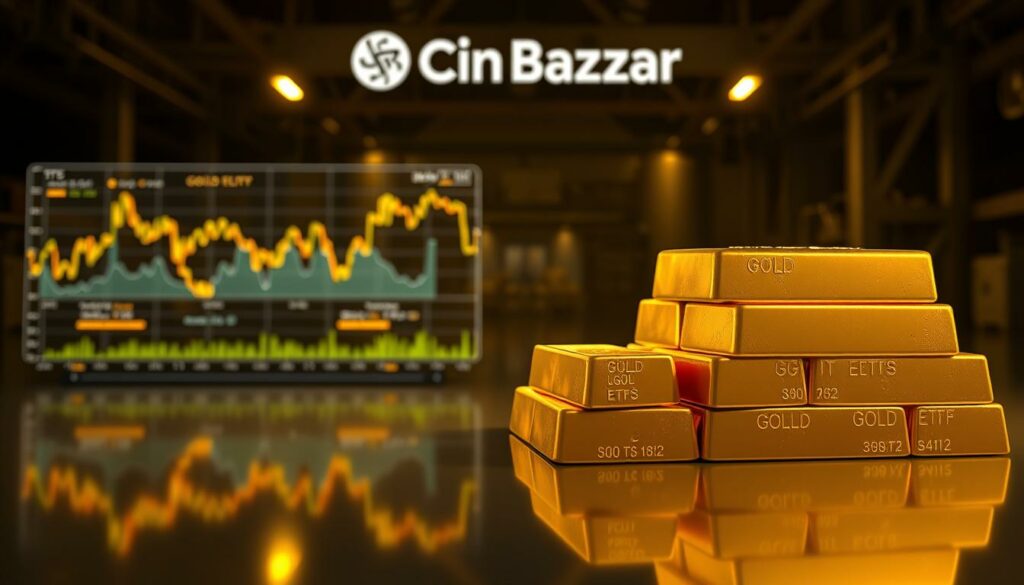

What Constitutes Physical Gold Investment?
Physical gold investment means owning gold in its real form, like coins, bars, or jewelry. Its value depends on its weight and purity.
Forms of Physical Gold
Physical gold can be invested in several ways:
- Gold Coins
- Gold Bars
- Jewelry
Purity Standards in India
In India, gold purity is measured in carats, with 24-carat being the purest. But, for investing, 22-carat and 24-carat gold are usually chosen.
Key Differences Between Gold ETFs and Physical Gold
Exploring gold investments in 2025 means knowing the difference between Gold ETFs and physical gold. This knowledge helps you choose the right investment for your financial goals.
Ownership Structure
Gold ETFs and physical gold have different ownership structures. Gold ETFs let you buy units of a fund that holds gold for you. You don’t own the gold directly. Physical gold, however, lets you hold the gold yourself, offering a sense of security.
Gold ETFs have a more abstract ownership, as the gold is stored by a third-party custodian. This is good for those who don’t want to handle storing physical gold.
Storage Requirements
Storing physical gold requires careful consideration. You need to keep it safe, which can cost extra for safe deposit boxes or home safes. Gold ETFs, on the other hand, don’t need personal storage, as the gold is kept by the fund’s custodian. This is a big plus for those without space or who don’t want to store gold.
Liquidity Comparison
Liquidity is where Gold ETFs and physical gold differ. Gold ETFs are traded on stock exchanges, making them easy to buy and sell. This liquidity lets you quickly react to market changes. Physical gold, while liquid, can be harder to sell quickly, as it takes time to find a buyer or sell to a dealer.
Cost Analysis: ETFs vs Physical Gold
When deciding between Gold ETFs and physical gold, it’s key to look at the costs. Knowing these costs helps you pick the best investment for your goals.
Initial Investment Requirements
Gold ETFs usually need less money to start compared to physical gold. You can begin with a small amount, making it easier to get into. Buying physical gold, like bars or coins, often requires more money upfront.
Ongoing Expenses and Fees
Gold ETFs might need less money to start, but they have ongoing fees. These fees can reduce your earnings over time. Physical gold, however, doesn’t have management fees. But, you might pay for storage and security.
Long-term Cost Implications
Looking at long-term costs, Gold ETFs might be more flexible and cost-effective. But, their management fees can add up. It’s important to think about these costs and the physical gold investment benefits based on your time frame.
Choosing between Gold ETFs and physical gold depends on your financial situation and goals. By understanding the costs of both, you can make a choice that fits your needs.
Security Considerations for Both Investment Types
Investing in gold, whether through ETFs or physical assets, has its own risks. Knowing these risks is key to smart investing in 2025.
Risks Associated with Gold ETFs
Gold ETFs are handy but carry specific risks. These include:
-
- Counterparty Risk: The risk that the counterparty (e.g., the ETF issuer or custodian) fails to deliver on their obligations.
Counterparty Risk
Counterparty risk is a big worry with Gold ETFs. If the counterparty defaults, you might struggle to get your money back.
-
- Market Risk: Changes in the gold price can impact the value of your ETF shares.
Market Risk
Market risk is a big deal with Gold ETFs, as their value depends on gold prices. Keeping up with market trends is key to managing this risk.
Risks Associated with Physical Gold
Physical gold investments also have their own risks, including:
-
- Theft and Storage Risks: Physical gold is at risk of theft and needs safe storage.
Theft and Storage Risks
To reduce theft and storage risks, think about using a safe deposit box at a bank or a secure storage facility.
-
- Authenticity Concerns: It’s vital to ensure the gold you buy is real to avoid fakes.
Authenticity Concerns
Buy from trusted dealers and check the gold’s authenticity to avoid counterfeit items.
Knowing the security risks of both Gold ETFs and physical gold helps you make better investment choices in 2025.
Liquidity and Accessibility Factors
When choosing between gold ETFs and physical gold, knowing their liquidity is crucial. Liquidity means how fast and easy it is to buy or sell an investment without big price changes.
How Quickly Can You Buy and Sell?
Gold ETFs are very liquid because they trade on stock exchanges all day. You can buy or sell them at the current market price, making it simple to get in or out of the market fast. Physical gold, however, can be harder to sell quickly, especially in big amounts.
- Gold ETFs can be traded throughout the day
- Physical gold may take longer to sell
- Market demand affects liquidity
Market Hours and Accessibility
Gold ETFs are available during stock market hours, letting you respond to market changes right away. Physical gold, however, is bought and sold during business hours at bullion dealers or banks. The ease of accessing gold ETFs online adds to their appeal.
Key benefits of gold ETFs include:
- Easy online access
- Trading flexibility during market hours
- Quick execution of trades
Comparing gold ETFs and physical gold shows both have good points. But if you value quick access and liquidity, gold ETFs might be better for you in 2025.
Tax Implications for Indian Investors
Indian investors face different tax rules when choosing between gold ETFs and physical gold. Knowing these rules is key to making smart investment choices.
Taxation on Gold ETFs in India
Gold ETFs have their own tax rules. You need to think about capital gains tax and securities transaction tax when investing in them.
Capital Gains Tax Structure
Capital gains tax on gold ETFs depends on how long you hold them. If you sell within 36 months, it’s short-term capital gains. This is taxed based on your income tax slab.
If you hold them more than 36 months, it’s long-term capital gains. This is taxed at 20% with indexation benefits.
Securities Transaction Tax
There’s a securities transaction tax on selling gold ETFs. This tax is 0.001% of the transaction value.
Taxation on Physical Gold in India
Physical gold has different tax rules than gold ETFs. You need to consider wealth tax and GST, along with making charges.
Wealth Tax Considerations
Wealth tax used to apply to physical gold above a certain amount. But, India abolished wealth tax. Now, there’s no wealth tax on gold. Still, it’s important to keep up with any tax law changes.
GST and Making Charges
GST is charged on buying physical gold, including making charges for jewelry. The GST rate changes, so it’s important to include these costs in your investment planning.
| Investment Type | Tax Applicable | Tax Rate |
|---|---|---|
| Gold ETFs (Short-term) | Capital Gains Tax | As per income tax slab |
| Gold ETFs (Long-term) | Capital Gains Tax | 20% with indexation |
| Physical Gold | GST | Applicable GST rate |
Knowing these tax rules helps you decide between gold ETFs and physical gold.
Gold ETFs vs Physical Gold: Performance Analysis
Exploring gold investments, it’s key to compare gold ETFs and physical gold. Investors must grasp how these options have performed to make smart choices.
Gold ETF Performance Trends (2020-2025)
Gold ETFs have tracked gold prices well, making them a simple investment choice. From 2020 to 2025, they’ve grown a lot. Some top ETFs have matched gold’s spot price closely. This has made them appealing to investors.
| Year | Gold ETF Returns | Physical Gold Returns |
|---|---|---|
| 2020 | 25% | 24.5% |
| 2021 | 10% | 9.8% |
| 2022 | 5% | 4.9% |
| 2023 | 8% | 7.9% |
| 2024 | 12% | 11.8% |
| 2025 | 15% | 14.9% |
Physical Gold Value Appreciation
Physical gold is a top choice for investors, offering a real asset that grows over time. Its value has risen from 2020 to 2025, thanks to global economic worries and demand for safe assets. Investing in physical gold can diversify your portfolio and protect against inflation.
The worth of physical gold is tied to its purity, with 24-karat gold being the most valuable. Investors can pick from coins, bars, and jewelry, each with its own benefits.
Market Trends Shaping Gold Investments in 2025
As we enter 2025, the gold investment scene is changing a lot. You’ll see a big change in how people view and invest in gold. This is because of many market trends.
Digital Gold Revolution in India
The digital gold revolution is growing fast in India. It makes investing in gold online easier than ever. Now, you can buy and sell gold with just a few clicks.
- Convenience of online transactions
- Increased accessibility to gold investment
- Reduced need for physical storage
Changing Investor Demographics
Who invests in gold is changing, with younger people preferring digital gold. This shift is affecting the gold market trends.
Economic Factors Influencing Gold Markets
Economic factors like inflation, currency changes, and global tensions are big influences on gold prices. When choosing between gold ETFs and physical gold, these factors are important to consider.
Key economic factors to watch:
- Inflation rates
- Currency fluctuations
- Geopolitical tensions
Knowing these trends is key to making smart gold investment choices in 2025.
Gold ETFs: Advantages and Disadvantages
Gold ETFs have their own set of benefits and drawbacks. They are a key part of gold investment in 2025. Knowing about Gold ETFs is important for smart investment choices.
Key Benefits of Gold ETF Investment
Gold ETFs are appealing for several reasons. They offer convenience by avoiding the need for physical storage. This means no worries about keeping gold safe.
They also provide liquidity, making it easy to buy and sell shares. This is great for those who want to quickly adjust their investments. Plus, Gold ETFs help with diversification, letting investors add gold to their portfolio without physical gold.
Another benefit is the ability to trade throughout the day. This lets investors quickly respond to market changes. This is especially useful in volatile markets.
Limitations of Gold ETFs
Gold ETFs also have some downsides. One major concern is counterparty risk. This happens because Gold ETFs rely on third parties to hold the gold. If these parties face financial trouble, investors might lose their money.
Gold ETFs can also have tracking errors. This means their performance might not match the actual gold price. This can happen due to fees and other operational issues.
Lastly, Gold ETFs don’t offer the same tangible ownership as physical gold. For some, not owning gold directly can be a big drawback, especially in uncertain times.
Physical Gold: Advantages and Disadvantages
Investing in gold can be a smart move, but it comes with its own set of pros and cons. Knowing these can help you make a better choice.
Benefits of Owning Physical Gold
There are many good things about owning physical gold. Here are some of the main benefits:
- Tangible Ownership: You get to own and control your gold directly.
- Hedge Against Inflation: Gold’s value often goes up when prices rise, making it a good hedge.
- No Counterparty Risk: You don’t have to worry about someone else defaulting, as you own the gold outright.
These points make physical gold a solid choice for those looking for a safe investment.
Drawbacks of Physical Gold Ownership
However, owning physical gold isn’t without its challenges:
- Storage and Security Concerns: Keeping your gold safe can be expensive and hard to manage.
- Liquidity Issues: Selling physical gold can be slower than selling ETFs, needing physical delivery and checks.
- Insurance Costs: Protecting your gold from theft or loss adds to the cost of owning it.
It’s important to know these downsides to make a smart investment choice.
Popular Gold ETFs in the Indian Market for 2025
Gold ETFs are becoming a top choice for investors in India. They offer a way to diversify portfolios in 2025. The ease of investment and no need for physical storage make them popular.
Top-Performing Gold ETFs
The best gold ETFs in India are picked based on several factors. These include expense ratios, tracking errors, and more. They are managed by well-known asset management companies.
Expense Ratio Comparison
The expense ratio is key when choosing a gold ETF. It affects your investment returns. Here’s a look at the expense ratios of top gold ETFs:
| Gold ETF | Expense Ratio (%) |
|---|---|
| Gold ETF A | 0.25 |
| Gold ETF B | 0.30 |
| Gold ETF C | 0.20 |
Tracking Error Analysis
Tracking error shows how closely a gold ETF tracks gold prices. A lower error is better.
| Gold ETF | Tracking Error (%) |
|---|---|
| Gold ETF A | 0.05 |
| Gold ETF B | 0.10 |
| Gold ETF C | 0.02 |
Selection Criteria for Gold ETFs
Choosing a gold ETF involves several factors. Look at expense ratios, tracking errors, and past performance. Also, consider the fund manager’s skills and the ETF’s liquidity.
Key considerations include:
- Low expense ratio
- Minimal tracking error
- Strong historical performance
- High liquidity
Physical Gold Investment Options in India
India has many physical gold investment choices. You can pick from different gold forms, each with its own benefits and things to think about.
Gold Coins and Bars
Gold coins and bars are favorites among Indian investors. They come in various weights and purities, offering flexibility. Gold coins are made by government-approved agencies, ensuring they’re real. Bars range from small to large, fitting different investment sizes.
When buying gold coins and bars, it’s key to deal with trusted sellers. This helps avoid fake products.
Jewelry as Investment
Jewelry is a common gold investment in India. It’s both a decoration and an investment. However, making jewelry can add higher making charges to your investment cost.
The resale value of jewelry is often less than its original price. This is because of making charges and the inclusion of other metals. Yet, many see jewelry’s emotional and aesthetic value as making it a good investment.
Sovereign Gold Bonds
Sovereign Gold Bonds (SGBs) offer a unique blend of physical gold and government-backed security. Issued by the Reserve Bank of India for the Government of India, SGBs are in grams of gold. They come with a fixed interest rate.
The main advantages of SGBs include avoiding storage costs and earning interest on your gold. The key benefits of SGBs include avoiding storage costs and earning interest on your gold.
When looking at physical gold investments, it’s important to consider the pros and cons. Think about storage, security, and how easy it is to sell. Knowing your options helps you choose what fits your investment goals.
Investor Profiles: Who Should Choose What?
In 2025, investors must decide between gold ETFs and physical gold. Your choice depends on your profile, financial goals, and how much risk you can take.
Ideal Scenarios for Gold ETF Investment
Gold ETFs are great for some investors. They are easy to use and don’t need physical storage.
For Young Professionals
Young professionals like gold ETFs. They are tech-savvy and enjoy online transactions. They can manage their gold investments easily online.
For Digital-First Investors
Those who like digital assets will like gold ETFs. They can be traded like stocks, making them flexible and liquid.
When Physical Gold Makes More Sense
Physical gold is better for some investors. It’s a real asset that can be held and stored.
For Traditional Investors
Traditional investors prefer physical gold. It feels secure and real, unlike digital investments.
For Long-term Wealth Preservation
Those looking to keep wealth long-term often choose physical gold. It’s a safe store of value, unlike gold ETFs.
| Investor Profile | Recommended Investment | Key Reasons |
|---|---|---|
| Young Professionals | Gold ETFs | Convenience, digital accessibility |
| Digital-First Investors | Gold ETFs | Flexibility, liquidity |
| Traditional Investors | Physical Gold | Tangibility, historical value |
| Long-term Investors | Physical Gold | Wealth preservation, store of value |
Building a Balanced Gold Portfolio in 2025
A well-diversified gold portfolio is key to successful investing in 2025. It’s important to mix gold ETFs and physical gold for the best results. This balance can help you maximize your returns.
Combining ETFs and Physical Gold
Using both gold ETFs and physical gold in your portfolio has its advantages. Gold ETFs are easy to trade and liquid. Physical gold, on the other hand, is a tangible asset that protects against inflation and market ups and downs.
By spreading your investments between ETFs and physical gold, you build a strong portfolio. This portfolio is better prepared for market changes.
Portfolio Allocation Strategies for Indian Investors
Indian investors might put a big chunk of their gold portfolio into ETFs for their liquidity. At the same time, they should also invest in physical gold. This is because physical gold offers real value and acts as a hedge.
Think about your investment goals and how much risk you can take. A mix of both ETFs and physical gold can help you deal with the gold market’s challenges in 2025.
With a balanced strategy, you can fully benefit from the gold market’s opportunities.
Conclusion: Making the Right Gold Investment Choice in 2025
When looking at gold investments in 2025, knowing the difference between gold ETFs and physical gold is key. Your choice depends on your goals, how much risk you can take, and what you prefer. Gold ETFs are easy to invest in and save money, thanks to their convenience and low costs.
Physical gold, on the other hand, is a real asset that can protect against inflation and market ups and downs. Think about who owns the gold, where to store it, and taxes when deciding between ETFs and physical gold.
By looking at the good and bad of each option, you can pick the best fit for your money goals. Whether you go for gold ETFs or physical gold, a balanced portfolio is essential for long-term wealth.







